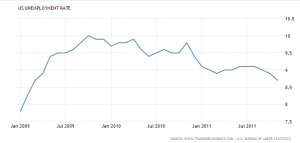 It’s a bad economy. Job searches have not been successful. Young people are running out of options.
It’s a bad economy. Job searches have not been successful. Young people are running out of options.
What can they do?
Perhaps joining the military is not a bad idea.
This may have been a thinking process for the youth during recession in the U.S.. In 2011, non-profit research organization National Priority Project (NPP) has published a military recruitment research for 2010. According to the NPP research, there was not enough data to prove a correlation between unemployment rate and recruitment rate. However, it does infer how the poor economy may drive youths to think of military as a career option.
According to NPP, the accession rate increased from FY2009 to FY2010, which indicates how more people wanted to join the military. By the FY2011 recruitment period, the US military already fulfilled the whole year’s recruitment demand and the half of FY2012’s recruitment goal. Comparing NPP’s analysis and the U.S. unemployment rate from U.S. Bureau of Labor Statistics, the correlation between the unemployment rate and demand for youth to join the military seems to make more sense. Looking at the unemployment rate trend from the end of 2009 to the beginning of 2011, the unemployment rate fluctuate between 10% and 9%. Considering the recruitment dates starting on September-October period, the unemployed youth may have felt hopelessness on looking for jobs; consecutively, they thought of enlisting.
As mentioned above, the recruitment goal for FY2011 overfilled the government’s demand. Consecutively, the government would want less recruits on next recruitment period. Of course, there the other factors influencing the military recruitment. For instance, 9/11 incident inspired many young Americans due to the rising patriotism. Yet, the recruitment goals by the year of 2005 supports correlation between unemployment rate and enlisting rate because the goal “had fallen short of its 80,000-person” according to New York Times.
To meet the recruitment goal, the U.S. military needs either inspire or scare to influence the American youth so the recruitment goal is met. There is a myriad ways to influence the public, but Business Insider and New York times theorized how Marine Corps advertisements may be the economic indicator that speaks about the correlation between unemployment rate and enlisting rate.
Business Insider and New York Times suggest that the intensity of Marine recruitment advertisements can be a measure of economy. The general concept goes something like this: when people cannot find suitable jobs due to bad economy, the Marine Corps terrifies the potential recruits with intense imagery in the advertisements because the Marine Corps does not want too many recruits. Though there is no easy to measure the intensity of the advertisements due to its qualitative nature, it is certainly interesting to look at in the light of communication.
The proof Business Insider and New York Times provides is the comparison of advertisements after and before the year of 2002. In 2002, the Marine Corps released an advertisement called “The Climb”. The advertisement showcased a man rock-climbing on a cliff. As the man ascends, the imagery of deployment, courageous Marines, American flag, troops helping people in needs, and many patriotic symbols appear on the cliff. At the end of the climbing, the man sees himself in the Marine uniform. The man gets picked up by himself in the uniform and they emerge into a proud Marine with a halo his back. Watching “The Climb”, being a Marine does not seem to be a bad idea. After watching the advertisement, it does not seem to matter how hard the training is because being a Marine looks like the most worthwhile occupation in the world. This advertisement highlights the slogan of Marine Corps “The Few, The Proud” because the advertisement sends powerful imagery to state how every recruit can become a proud Marine after a rigorous training and self-development.
The advertisement on the 2002 definitely seems to attract many recruits. On the year of 2008, however, the advertisement changed the look of military. Preparing the next fiscal year, the Marine Corps released “America’s Few” advertisement. The advertisement starts with young men from different backgrounds. They rally at the same location and the scene shifts to the series of hardcore training the cadets go through. The commercial shows the images of very intense training such as rope climbing, diving into the water with full battle gears , getting exposed to tear gas, training in the mud, getting thrown into the hand to hand combat with no protective gears, war simulations, and rigorous combat practices.
Towards the end of the commercial, the narrator says that only a few can earn the title of proud Marines. Compare to the 2002 commercial, the advertisement on 2008 highlights how selective the Marine Corps is on picking its candidates. The images of trainees in pain from the training were repeating throughout the commercial. If the 2002 commercial was about the glory of becoming a Marine to attract many candidates, the 2008 commercial was definitely about influencing potential candidates to be hesitant on enlisting. On the year of 2009, the unemployment rate was 9.8% on September. In other words, there may have been a need to reduce the number of candidates to the Marine Corps as the unemployment rate rose; hence, “The Few” was more emphasized in the commercial than “The Proud”.
Of course it is not an accurate measure because the intensity can be subjective; however, the Marine Corps advertisement intensity index certainly has a value of studying. It definitely reflect on how the government communicates with people for the supply and demand. Just as other economic indicators influence how people feel about economy, Marine Corps advertisement intensity index influence how people feel about the government’s demand and supply.




Leave a Reply
You must be logged in to post a comment.